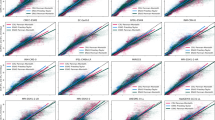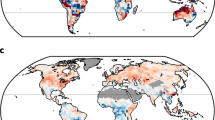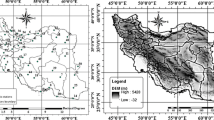Abstract
A monthly water-balance model is used with CRUTS3.1 gridded monthly precipitation and potential evapotranspiration (PET) data to examine changes in global water deficit (PET minus actual evapotranspiration) for the Northern Hemisphere (NH) for the years 1905 through 2009. Results show that NH deficit increased dramatically near the year 2000 during both the cool (October through March) and warm (April through September) seasons. The increase in water deficit near 2000 coincides with a substantial increase in NH temperature and PET. The most pronounced increases in deficit occurred for the latitudinal band from 0 to 40°N. These results indicate that global warming has increased the water deficit in the NH and that the increase since 2000 is unprecedented for the 1905 through 2009 period. Additionally, coincident with the increase in deficit near 2000, mean NH runoff also increased due to increases in P. We explain the apparent contradiction of concurrent increases in deficit and increases in runoff.





Similar content being viewed by others
References
Allen RG, Smith M, Pereira LS, Perrier A (1994) An update for the calculation of reference evapotranspiration. ICID Bulletin 43:35–92
Apipattanavis S, McCabe GJ, Rajagopalan B, Gangopadhyay S (2009) Joint spatiotemporal variability of global sea surface temperatures and global Palmer drought severity index values. J Clim 22:6251–6267. doi:10.1175/2009JCLI2791.1
Arnell NW (2003) Effects of IPCC SRES emissions scenarios on river runoff: a global perspective. Hydrol Earth Syst Sci 7:619–641
Arora VK (2002) The use of the aridity index to assess climate change effect on annual runoff. J Hydrol 265:164–177
Budyko MI (1948) Evaporation under natural conditions. Gidrometeorizdat, Leningrad, English translation by IPST, Jerusalem
Burke EJ, Brown SJ (2008) Evaluating uncertainties in the projection of future drought. J Hydrometeorol 9:292–299
Chen X, Tung K-K (2014) Varying planetary heat sink led to global-warming slowdown and acceleration. Science 345:897–903. doi:10.1126/science.1254937
Intergovernmental Panel on Climate Change (2014) Summary for Policymakers. In: Climate Change 2014: Impacts, Adaptation, and Vulnerability. Part A: Global and Sectoral Aspects. Contribution of Working Group II to the Fifth Assessment Report of the Intergovernmental Panel on Climate Change, Field CB, Barros VR, Dokken DJ, Mach KJ, Mastrandrea MD, Bilir TE, Chatterjee M, Ebi KL, Estrada YO, Genova RC, Girma B, Kissel ES, Levy AN, MacCracken S, Mastrandrea PR, and White LL (eds.), Cambridge University Press, Cambridge, United Kingdom and New York, NY, USA
Dai A (2011) Drought under global warming: a review. WIREs Clim Chang 2:45–65. doi:10.1002/wcc.81
Dai A (2013) Increasing drought under global warming in observations and models. Nat Clim Chang 3:52–58
Dai A, Trenberth KE, Qian T (2004) A global data set of palmer drought severity index for 1870–2002: relationship with soil moisture and effects of surface warming. J Hydrometeorol 5:1117–1130
Dobrowski SZ, Abatzoglou J, Swanson AK, Greenberg JA, Mynsberge AR, Holden ZA, Schwartz MK (2013) The climate velocity of the contiguous United States during the 20th century. Glob Chang Biol 19:241–251. doi:10.1111/gcb.12026
Easterling DR, Wehner MF (2009) Is the climate warming or cooling? Geophys Res Lett 36:L08706. doi:10.1029/2009GL037810
Ekstrom M, Jones PD, Fowler HF, Lenderink G, Buishand TA, Conway D (2007) Regional climate model data used within the SWURVE project 1: projected changes in seasonal patterns and estimation of PET. Hydrol Earth Syst Sci 11:1069–1083
England MH, McGregor S, Spence P, Meeh GA, Timmermann A, Cai W, Gupta AS, McPhaden MJ, Purich A, Santoso A (2014) Recent intensification of wind-driven circulation in the Pacific and the ongoing warming hiatus. Nat Clim Chang 4:222–227
Falkenmark M, Rockstrom J (2006) The new blue and green water paradigm: breaking new ground for water resources planning and management. J Water Res Pl-ASCE May/June, 129–132
Gleick PH (2000) Water: the potential consequences of climate variability and change for the water resources of the U.S. The Report of the Water Sector Assessment Team of the National Assessment of the Potential Consequences of Climate Variability and Change, Pacific Institute for Studies in Development, Environment, and Security, Oakland, 151
Hoerling MP, Kumar A (2003) The perfect ocean for drought. Science 299:691–694
Kaplan A, Cane M, Kushnir Y, Clement A, Blumenthal M, Rajagopalan B (1998) Analyses of global sea surface temperature 1856–1991. J Geophys Res 103:18,567–18,589
McCabe GJ, Markstrom SL (2007) A monthly water-balance model driven by a graphical user interface. U.S. Geological Survey Open-File report 2007–1088, 6 p
McCabe GJ, Palecki MA (2006) Multidecadal climate variability of global lands and oceans. Int J Climatol 26:849–865. doi:10.1002/joc.1289
McCabe G, Wolock DM (2008) Joint variability of global runoff and global sea surface temperatures. J Hydrometeorol 9:816–824. doi:10.1175/2008JHM943.1
McCabe GJ, Wolock DM (2011) Independent effects of temperature and precipitation on modeled runoff in the conterminous United States. Water Resour Res 47:W11522. doi:10.1029/2011WR010630
McCabe GJ, Wolock DM (2014) Temporal and spatial variability of the global water balance. Clim Chang. doi:10.1007/s10584-013-0798-0
McDonald RI, Girvetz EH (2013) Two challenges for U.S. irrigation due to climate change: increasing irrigated area in wet states and increasing irrigation rates in dry states. PLoS ONE 8(6):e65589. doi:10.1371/journal.pone.0065589
Meehl GA, Teng H (2014) CMIP5 multi-model hindcasts for the mid-1970s shift and early 2000s hiatus and predictions for 2016–2035. Geophys Res Lett 41:1711–1716
Milly PCD, Dunne KA, Vecchia AV (2005) Global pattern of trends in streamflow and water availability in a changing climate. Nature 438:347–350. doi:10.1038/nature04312
Montieth JL (1964) Evaporation and environment. Symp Soc Exp Biol 19:205–234
Nijssen B, O’Donnell GM, Hamlet A, Lettenmaier DP (2000) Hydrologic sensitivity of global rivers to climate change. Clim Chang 50:515–517
Redmond KT, Koch RW (1991) Surface climate and streamflow variability in the western United States and their relationship to large scale circulation indices. Water Resour Res 27:2381–2399. doi:10.1029/91WR00690
Rind D, Goldberg R, Hansen J, Rosenzweig C, Ruedy R (1990) Potential evapotranspiration and the likelihood of future drought. J Geophys Res 95:9983–10004
Seager R, Ting M, Held I, Kushnir Y, Lu J, Vecchi G, Huang H-P, Harnik N, Leetmaa A, Lau N-C, Li C, Velez J, Naik N (2007) Model projections of an imminent transition to a more arid climate in southwestern North America. Science 316:1181–1184
Sheffield J, Wood EF (2008) Projected changes in drought occurrence under future global warming from multi-model, multi-scenario, IPCC AR4 simulations. Clim Dyn 31:79–105
Sheffield J, Wood EF, Roderick ML (2012) Little change in global drought over the past 60 years. Nature 491:435–440. doi:10.1038/nature11575
Shuttleworth WJ (1993) In: Maidment DR (ed) Handbook of hydrology. McGraw-Hill, New York, pp 4.1–4.53
Steinman BA, Mann ME, Miller SK (2015) Atlantic and Pacific multidecadal oscillations and Northern Hemisphere temperatures. Science 347:988–991
Stephenson N (1990) Climatic control of vegetation distribution: the role of the water balance. Am Naturalist 135:649–670
Stephenson NL (1998) Actual evapotranspiration and deficit: biological meaningful correlates of vegetation distribution across spatial scales. J Biogeogr 25:855–870
Trenberth KE (1997) The definition of El Niño. Bull Am Meteorol Soc 78:2771–2777
Wang GL (2005) Agricultural drought in a future climate: results from 15 global climate models participating in the IPCC 4th assessment. Clim Dyn 25:739–753
Weiskel PK, Wolock DM, Zarriello PJ, Vogel RM, Levin SB, Lent RM (2014) Hydroclimatic regimes: a distributed water-balance framework for hydrologic assessment and classification. Hydrol Earth Syst Sci Discuss 11:2933–2965. www.hydrol-earth-syst-sci-discuss.net/11/2933/2014/, doi:10.5194/hessd-11-2933-2014
Willmott CJ, Feddema JJ (1992) A more rational climatic moisture index. Professor Geogr 44:84–88. doi:10.1111/j.0033-0124.1992.00084.x
Wolock DM, McCabe GJ (1999) Effects of potential climatic change on annual runoff in the conterminous United States. J Am Water Resour Assoc 35:1341–1350
Author information
Authors and Affiliations
Corresponding author
Rights and permissions
About this article
Cite this article
McCabe, G.J., Wolock, D.M. Increasing Northern Hemisphere water deficit. Climatic Change 132, 237–249 (2015). https://doi.org/10.1007/s10584-015-1419-x
Received:
Accepted:
Published:
Issue Date:
DOI: https://doi.org/10.1007/s10584-015-1419-x




